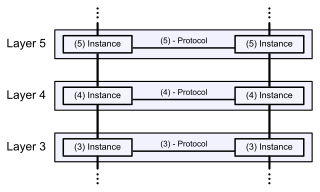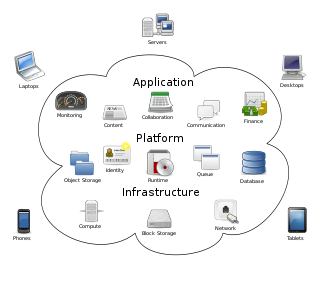Related Research Articles

The Open Systems Interconnection model is a reference model from the International Organization for Standardization (ISO) that "provides a common basis for the coordination of standards development for the purpose of systems interconnection." In the OSI reference model, the communications between systems are split into seven different abstraction layers: Physical, Data Link, Network, Transport, Session, Presentation, and Application.

In computing, load balancing is the process of distributing a set of tasks over a set of resources, with the aim of making their overall processing more efficient. Load balancing can optimize the response time and avoid unevenly overloading some compute nodes while other compute nodes are left idle.
In computer science, program analysis is the process of automatically analyzing the behavior of computer programs regarding a property such as correctness, robustness, safety and liveness. Program analysis focuses on two major areas: program optimization and program correctness. The first focuses on improving the program’s performance while reducing the resource usage while the latter focuses on ensuring that the program does what it is supposed to do.

Investment banking pertains to certain activities of a financial services company or a corporate division that engages in providing advisory-based services on financial transactions for clients, such as institutional investors, corporations, and governments. Traditionally associated with corporate finance, such a bank might assist in raising financial capital by underwriting or acting as the client's agent in the issuance of debt or equity securities. An investment bank may also assist companies involved in mergers and acquisitions (M&A) and provide ancillary services such as market making, trading of derivatives and equity securities, FICC services or research. Most investment banks maintain prime brokerage and asset management departments in conjunction with their investment research businesses. As an industry, it is broken up into the Bulge Bracket, Middle Market, and boutique market.

Universal Plug and Play (UPnP) is a set of networking protocols on the Internet Protocol (IP) that permits networked devices, such as personal computers, printers, Internet gateways, Wi-Fi access points and mobile devices, to seamlessly discover each other's presence on the network and establish functional network services. UPnP is intended primarily for residential networks without enterprise-class devices.
A conflict of interest (COI) is a situation in which a person or organization is involved in multiple interests, financial or otherwise, and serving one interest could involve working against another. Typically, this relates to situations in which the personal interest of an individual or organization might adversely affect a duty owed to make decisions for the benefit of a third party.
Deep packet inspection (DPI) is a type of data processing that inspects in detail the data being sent over a computer network, and may take actions such as alerting, blocking, re-routing, or logging it accordingly. Deep packet inspection is often used for baselining application behavior, analyzing network usage, troubleshooting network performance, ensuring that data is in the correct format, checking for malicious code, eavesdropping, and internet censorship, among other purposes. There are multiple headers for IP packets; network equipment only needs to use the first of these for normal operation, but use of the second header is normally considered to be shallow packet inspection despite this definition.
A Chinese wall or ethical wall is an information barrier protocol within an organization designed to prevent exchange of information or communication that could lead to conflicts of interest. For example, a Chinese wall may be established to separate people who make investments from those who are privy to confidential information that could improperly influence the investment decisions. Firms are generally required by law to safeguard insider information and ensure that improper trading does not occur.
Deloitte Touche Tohmatsu Limited, commonly referred to as Deloitte, is a British multinational professional services network. Deloitte is the largest professional services network by revenue and number of employees in the world and is considered one of the Big Four accounting firms along with EY, KPMG and PwC.
IEEE 802.11i-2004, or 802.11i for short, is an amendment to the original IEEE 802.11, implemented as Wi-Fi Protected Access II (WPA2). The draft standard was ratified on 24 June 2004. This standard specifies security mechanisms for wireless networks, replacing the short Authentication and privacy clause of the original standard with a detailed Security clause. In the process, the amendment deprecated broken Wired Equivalent Privacy (WEP), while it was later incorporated into the published IEEE 802.11-2007 standard.

A hotspot is a physical location where people can obtain Internet access, typically using Wi-Fi technology, via a wireless local-area network (WLAN) using a router connected to an Internet service provider.
Information flow in an information theoretical context is the transfer of information from a variable to a variable in a given process. Not all flows may be desirable; for example, a system should not leak any confidential information to public observers—as it is a violation of privacy on an individual level, or might cause major loss on a corporate level.
A web framework (WF) or web application framework (WAF) is a software framework that is designed to support the development of web applications including web services, web resources, and web APIs. Web frameworks provide a standard way to build and deploy web applications on the World Wide Web. Web frameworks aim to automate the overhead associated with common activities performed in web development. For example, many web frameworks provide libraries for database access, templating frameworks, and session management, and they often promote code reuse. Although they often target development of dynamic web sites, they are also applicable to static websites.

A computer network is a set of computers sharing resources located on or provided by network nodes. Computers use common communication protocols over digital interconnections to communicate with each other. These interconnections are made up of telecommunication network technologies based on physically wired, optical, and wireless radio-frequency methods that may be arranged in a variety of network topologies.
Data loss prevention (DLP) software detects potential data breaches/data exfiltration transmissions and prevents them by monitoring, detecting and blocking sensitive data while in use, in motion, and at rest.
OAuth is an open standard for access delegation, commonly used as a way for internet users to grant websites or applications access to their information on other websites but without giving them the passwords. This mechanism is used by companies such as Amazon, Google, Meta Platforms, Microsoft, and Twitter to permit users to share information about their accounts with third-party applications or websites.

Cloud computing is the on-demand availability of computer system resources, especially data storage and computing power, without direct active management by the user. Large clouds often have functions distributed over multiple locations, each of which is a data center. Cloud computing relies on sharing of resources to achieve coherence and typically uses a pay-as-you-go model, which can help in reducing capital expenses but may also lead to unexpected operating expenses for users.
Internet censorship circumvention, also referred to as going over the wall or scientific browsing in China, is the use of various methods and tools to bypass internet censorship.
Software-defined networking (SDN) is an approach to network management that enables dynamic and programmatically efficient network configuration to improve network performance and monitoring in a manner more akin to cloud computing than to traditional network management. SDN is meant to improve the static architecture of traditional networks and may be employed to centralize network intelligence in one network component by disassociating the forwarding process of network packets from the routing process. The control plane consists of one or more controllers, which are considered the brains of the SDN network, where the whole intelligence is incorporated. However, centralization has certain drawbacks related to security, scalability and elasticity.
A distributed file system for cloud is a file system that allows many clients to have access to data and supports operations on that data. Each data file may be partitioned into several parts called chunks. Each chunk may be stored on different remote machines, facilitating the parallel execution of applications. Typically, data is stored in files in a hierarchical tree, where the nodes represent directories. There are several ways to share files in a distributed architecture: each solution must be suitable for a certain type of application, depending on how complex the application is. Meanwhile, the security of the system must be ensured. Confidentiality, availability and integrity are the main keys for a secure system.
References
- Harris, Shon, All-in-one CISSP Exam Guide, Third Edition, McGraw Hill Osborne, Emeryville, California, 2005.
- Chapple, Mike, et al, Certified Information System Security Professional - Official Study Guide, Eighth Edition, Sybex, John Wiley & Sons, Indiana, 2018.
